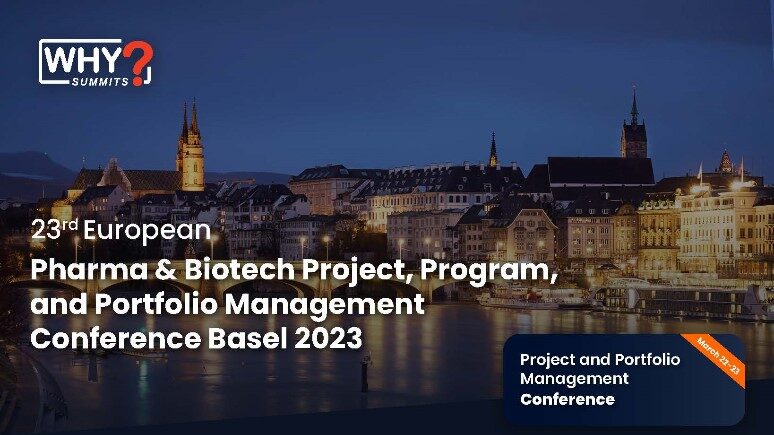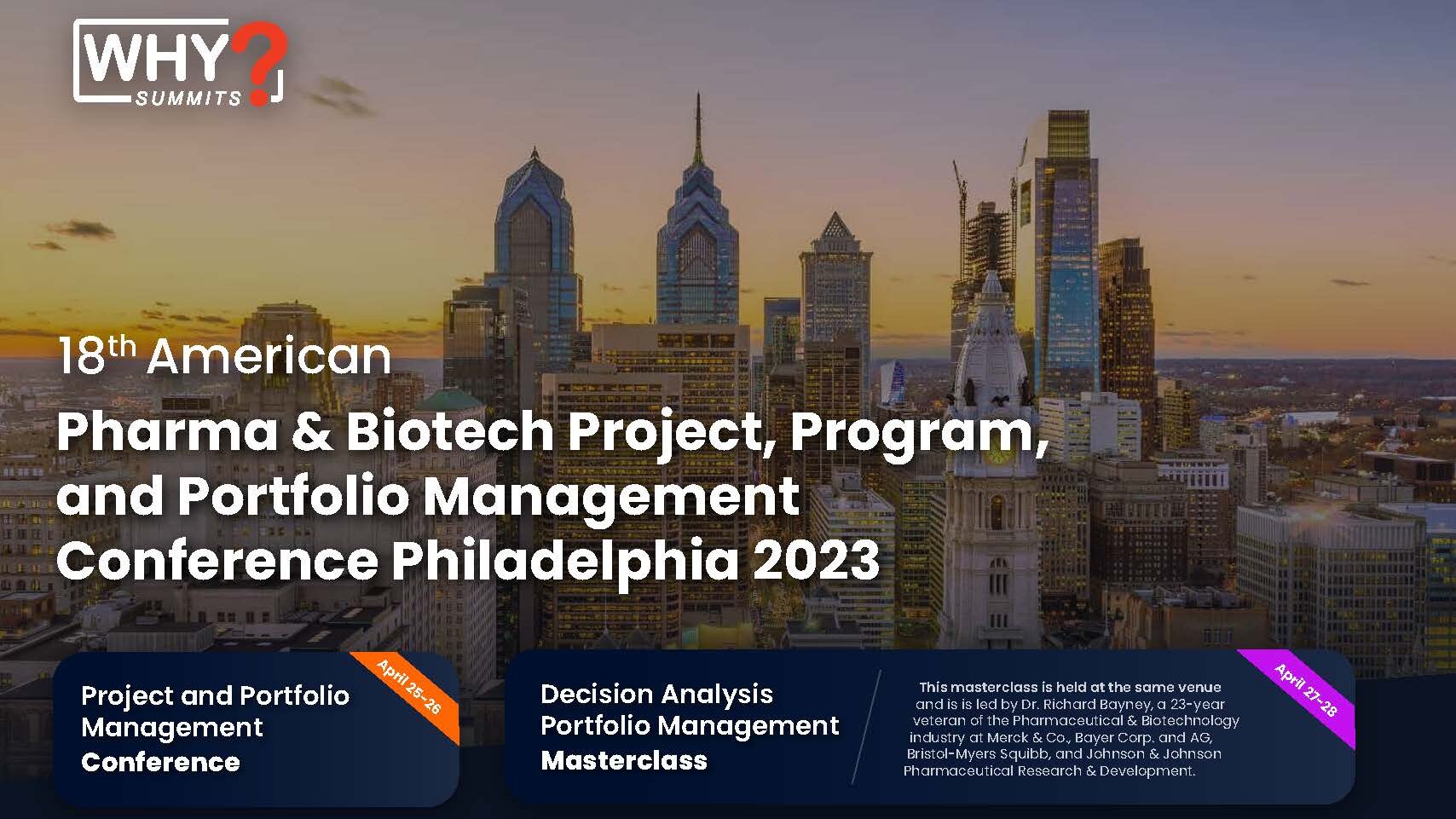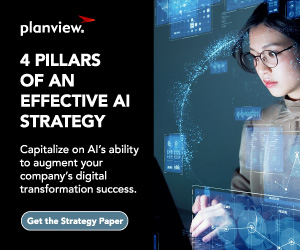
We were pleased to sponsor two occasions of the WHY Summit’s Annual Pharma & Biotech Project, Program, and Portfolio Management conferences in Basel, Switzerland, and Philadelphia, U.S. It was a pleasure to share and connect with so many members of the pharmaceutical and life sciences industry.
We also came away with some fantastic insights and learnings that we are excited to share with the rest of our community.
What is the WHY Summit
The WHY Summit gathers Project, Program, and Portfolio Managers from the pharmaceutical and healthcare industries to collaboratively address both new and recurring management challenges. Through the various events held in Europe and the United States, attendees engage in informative presentations and discussions on critical topics such as:
- The exploration of case studies, building and evolving portfolio management functions in organizations to identify best practices for mature portfolio management.
- Analyzing the role of project management at various levels of portfolio management maturity in different organizations.
- Solutions to project prioritization and selection methodologies for risk and decision analysis.
- How to encourage cross-functional teams to engage with external stakeholders.
- Market access considerations
- Exploring new work management best practices, such as agile methodologies and digital tools.
- Managing innovation, maturing products, R&D projects, and manufacturing initiatives.
Planview at the WHY Summit Conference:
On the Stage
At both events, Dr. Richard Sonnenblick, Chief Data Scientist at Planview, spoke about improving your portfolio planning capabilities through the broader lens of digital transformation.
In his discussion, he defined digital transformation in life sciences product portfolio management as more than just adopting a new set of tools or new methodologies. But he also devises an essential aspect of digital transformation as a means of leveling-up product portfolio management that many organizations miss out on—a crucial shift in mindset.
Dr. Sonnenblick stated that it takes some intangibles to truly actualize a digital transformation – the courage, drive, and commitment to change your perspective. Using examples from three Planview customers, he outlined several essential characteristics and success factors differentiating digital-forward companies. Through those examples, he illustrated how once those organizations genuinely grasped the changes necessary for accelerating their digital transformation, they used Planview to level up their approach to product portfolio management.
Key takeaways from the discussion included:
- Finding value in every transformation challenge by identifying the stages of maturity in a digital forward portfolio planning process
- Defusing the perceived threat of democratized data using best practices for promoting the collaboration and culture required to transform
- How to use this approach to elevate portfolio transparency and leverage the collective wisdom of your organization
You can watch a recording of his presentation here.
On the Floor
In addition to Dr. Sonnenblick’s keynote, both events offered many opportunities to learn from our colleagues working in various areas of life sciences. We were also fortunate enough to sit in on a round-table discussion about how AI and Machine Learning (ML) will impact portfolios and their manager’s day-to-day activities.
It Begins in Basel, Switzerland

While at Basel, representatives from Novartis spoke about the importance of asking and answering critical questions surrounding the management of early-stage, preclinical portfolios and suggested practices for improving visibility into project updates, reporting, and planning.
In addition, Ariceum Therapeutics gave an informative talk about defining a successful project, stating that it is similar to a pyramid structure. They said that building from the ground up upon a solid foundation of execution and defining what success looks like before a project starts are critical to achieving a desired outcome.
Closing out our time in Switzerland, we sat in on a talk from CSL Behring about applying AI/ML to project/program management and its value in selecting compounds for clinical trials when using more extensive datasets and more sensitive models.
Fast-forward to Philadelphia

During the WHY Summit in Philly, Wugen spoke about the need for robust scenario analysis to build a disease area portfolio that can account for product and trial dependencies, balance internally researched and partnered assets, and long- and short-term goals.
Experts from BMS (Bristol Myers Squibb) gave an eloquent and impassioned talk about the critical need for diversity and inclusivity in project management. They added promoting a work environment that encourages team members to voice their opinions and concerns can significantly enhance productivity and fairness, ultimately leading to a more stable and sustainable organization.
Lastly, Genentech discussed how digital transformation initiatives and AI capabilities are rewriting the rules of manufacturing, research, and development program management. They emphasized the importance of data sharing among drug development competitors through consortia and how it enables the industry to gain extensive insights into project performance and delivery risk using AI technology.
On the Topic of AI
During the Philadelphia event, several members of the Planview team participated in a roundtable discussion about the potential effects of AI/ML on portfolio and project management, as well as their daily tasks.
In this discussion, we asked participants to provide a wish list of potential AI/ML portfolio and project management features and capabilities. This request led to a handful of key insights, such as:
- Sentiment analysis, similar to the capabilities built into the Planview platform, is a critical need in the life sciences industry. Sentiment scoring is an excellent way to quickly surface potential issues to project managers without digging into detailed data at the task level.
- An AI/ML-driven early warning system was a top request for projects and portfolios. For example, participants envisioned visual indicators for all projects that have been excessively re-baselined due to scheduling or financial planning.
- Several attendees mentioned how AI could aid in building schedules and resource plans based on historical project performance and industry benchmarks. This is akin to enhanced project templates, especially concerning resource management portions of the plan.
- As expected, ChatGPT came up in discussion, with one project manager mentioning how they used the OpenAI platform to author a project charter and how it helped complete 80% of the effort. They noted that this was only applied to a generic project and would not use ChatGPT for competitive projects. Additionally, the AI writing tool did not replace the need to review and refine the project charter for validation or adding the human element.
Lastly, we were surprised to learn that many companies, especially smaller life sciences organizations, still rely on outdated and traditional methods like spreadsheets to manage their portfolios.
When relying on basic, static portfolio management methods, those responsible for reducing cycle time and accelerating innovation often spend too much time wrangling updates from team members. At Planview, we aim to enable quick adaptation through improved connectivity, so execution is never a barrier to delivering products aligned to strategy on time.
Many smaller life sciences organizations may assume that the portfolio management capabilities provided by Planview’s platform are unnecessary for their needs. However, this is not entirely accurate. Planview can be utilized at every level, and there is a use case for it in every organization.
More Resources
You can learn more about how Planview has helped other life sciences organizations accelerate innovation and reduce cycle time with a data-driven approach to product portfolio management that provides end-to-end visibility at every level.
Read about how this global pharma company worked with Planview Advisor to build a centralized source of data, advanced analytics, and portfolio prioritization.
Find out how this long-standing biopharma company uses Planview Advisor’s advanced analytics capabilities to uncover R&D value.




